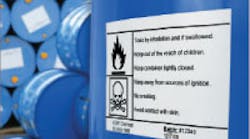Budget plus time plus resources is the formula for facility managers responsible for updating, reviewing and replacing safety signs. As budgets decrease, responsibilities and workloads increase among small staffs already stretched to maximum capacity. And yet safety signs and labels provide a layer of protection and communication to workers exposed to arc flash, lockout/tagout incidents and chemical hazards.
Despite these tough times, regulatory and logistical changes still advance the need for safety signs. OSHA 1910.145 requires safety signs be used to indicate specific hazards that, without identification, may lead to accidental injury to workers and/or the public or lead to property damage.
OSHA requires that danger signs must be red, white and black. Caution signs must be yellow, black and white. Safety instruction signs must be green and white. The sign’s wording should be easy to read, concise and contain sufficient information to be easily understood. Wording should be accurate and make a positive rather than negative suggestion.
Furthermore, OSHA requires signs to have rounded or blunt corners and be free of sharp edges, burrs, splinters or other sharp projections. OSHA also specifies that the means of attaching the sign to a wall, post or other supporting material must not cause a hazard.
Thomas L. Schulte, regional security manager of ISS Security Services, found that safety signs usually are replaced because:
➤ There has been a technological advances in materials.
➤ The sign’s appearance has degraded until it no longer is readable. Schulte says signs in the front of operations may be replaced more often than those in the back.
➤ The sign’s relevance has changed.
Jim Tweedy, executive director of the International Board for Certification of Safety Managers, suggests asking the following questions when assessing safety sign placement:
➤ Is the sign appropriate for the hazard or risk?
➤ Is the sign placed in the proper location to inform people of danger or the need for caution?
➤ Is the sign or warning used because the facility has failed or neglected to abate a correctable hazard or danger?
➤ Is there a more suitable sign available to replace an outdated sign?
➤ Has the facility changed layout or equipment placement, and if so, has there been a sign evaluation?
Labeling Innovations
Often, new labeling supplies are crafted for very specific applications that can range from adhesion, chemical resistance or abrasion. Specially engineered supplies have been developed for lasting performance on surfaces like oily drums, near electrical circuits or even on freezing pipes.
Examples of innovations include:
➤ Improved printer technology for printer portability and more durable labels;
➤ Advanced adhesives to label difficult surfaces like plastic, brick and wood;
➤ New materials to withstand tough environments – think Arizona sun;
➤ Color-coded wire and cable markings to indicate varied uses such as grounding, hot wiring and utility locations;
➤ Economical, custom color labels on continuous rolls;
➤ Non-adhesive labels which can be relocated for temporary applications; and
➤ Support products such as mobile print stations, printer carts and application sprays.
Facility managers can choose from hundreds of high performance safety labeling supplies for every budget, weather condition and application one might encounter.
A Global Sign
We are not isolated in our concern for industrial workplace safety. Major U.S. firms with overseas facilities, for example, represent just one facet of the global marketplace. Multinationals may employ thousands of workers from Boston to Bangkok. Standardizing safety practices, including signs and labels, ensures that messaging and communications are consistent.
Across Europe and Latin America, general safety, warning and exit signs tend to have fewer words and more imagery. Where more than one language is spoken, posted safety signs are typically bilingual. Additionally, new hazardous material labeling protocols (GHS) are being rolled out in Europe and will soon be required in the United States.
The European Agency for Health and Safety at Work (EU-OSHA) offers hazardous material labeling guidelines:
1. Labels must indicate the name of the substance, the origin of the substance (name and address of the manufacturer, distributor or importer), danger symbols, indication of danger involved in the use of the substance and a reference to the special risks arising from such dangers.
2. The dimensions of the label must not be less than those of a standard A8 sheet (52 x 74 mm), and each symbol must cover at least one-tenth of the surface area of the label. Member countries may require their national language or languages to be used in the labeling of dangerous substances.
The goal of the European Regulation Classification, Labeling and Packaging (CLP) is to have a consistent labeling system for chemicals placed on the global market, regardless of where they are made or used. The CLP label (diamond with a red border hazard pictogram) is replacing the existing European classification and labeling regime (orange square danger symbols) which were in place in Europe for more than 40 years. Efforts to standardize labeling fall under the auspices of United Nations Globally Harmonised System for the Classification and Labelling of Chemicals (GHS).
Whether you’re a safety manager in the U.K. or a facility manager from Connecticut, consistent use of safety signs plays a critical role in reducing injuries and saving lives at industrial facilities.
Steve Stephenson is the managing director of Graphic Products Inc. For more information, visit http://www.duralabel.com.

